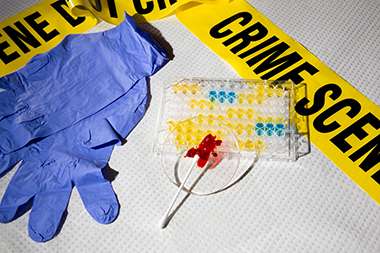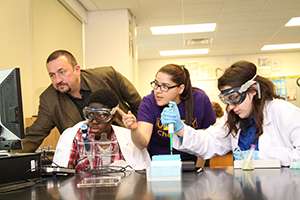Chemist unveils latest forensic discovery to identify criminals

First it was fingerprints. Now it's blood.
Ongoing forensic research led by University at Albany Assistant Chemistry Professor Jan Halámek and his team has revealed a simple way to estimate the age range of a culprit through blood residue left at a crime scene.
By analyzing alkaline phosphatase (ALP) levels, a biomarker found in all body tissues, his team can tell if the originator is young (under 18) or older, along with the time since deposition (TSD) of the blood spot.
ALP levels are age dependent according to Halámek, making the correlation relatively simple. His team is able to determine how many hours the sample has been left behind based on ALP's enzyme activity, which decreases over time. They've tested both discoveries by using "mimicked crime scene conditions" and real human serum samples, finding close to 100 percent accuracy for up to two days. Full results were published recently in Analytical Chemistry.
This is the second groundbreaking research paper Halámek has released regarding the use of body fluids biomarkers for identification. Last year, his team discovered a straight forward way to identify whether a culprit was male or female, based on amino acid content left behind in fingerprints. Levels are twice as high in the sweat of women as in that of men. It gained national attention, including features in the New York Times and Chemical & Engineering News.
"It's all about the biomarkers, looking for the attributes of a person," said Halámek in a recent interview with Forensic Magazine. "It's pure chemistry."

Halámek is hoping both discoveries may soon help investigators obtain key information about suspects. Though not intending to compete with traditional DNA analysis, he believes his tests provide quick results, and are simple to perform. They also can help match individuals who are not found through an existing DNA database.
"We would like to see our research packaged as a potential forensic kit and utilized by all law enforcement," Halámek said. "If these tests are made portable, they can be rapidly analyzed at the crime scene by individuals who have minimal scientific training."
To prove just how user-friendly his tests are, Halámek has let high schoolers in Averill Park, N.Y., give them a try. Most recently, students in Dr. Gregory Panzanaro's Introduction to Forensic Science class successfully performed the ALP analyzation in order to determine age range.
At UAlbany, students are also taking the lead on developing Halámek's research. Those on his team include Ph.D. chemistry students Erica Brunelle, Juliana Agudelo, Crystal Huynh and Leif McGoldrick, along with a number of chemistry and biology undergraduates.
"We hope to continue working with students on projects in our lab going forward. It is a great opportunity for them to gain real-world forensic experience," Halámek said.
Halámek and his team are currently looking at ways to enhance both the fingerprint and blood residue tests. They are also exploring additional identification methods related to other body fluids.
More information: Juliana Agudelo et al. Ages at a Crime Scene: Simultaneous Estimation of the Time since Deposition and Age of Its Originator, Analytical Chemistry (2016). DOI: 10.1021/acs.analchem.6b01169
Journal information: Analytical Chemistry
Provided by University at Albany




















